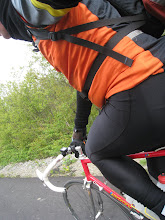+3 C is NOT cold
Every autumn we have to tune our cycling fashion sense towards surviving the cooler temperatures.
Some people conflate being cold with being outside in the cold, but the two are not the same thing at all.
It is easy to stay warm in the plus-side of the celsius temperature scale. Some experimentation may be required, so try out all your gear to determine your best gear for cool temperatures.
When you are cycling you are generating heat (that's if you are doing it right) and keeping the core warm is no problem after the first 10-15 minutes . The problem with the core it releasing the sweat you generate using your amazing cardiovascular system.
The problem is keeping the extremities warm, but modern fabric technology to the rescue!
The enemy of riders is wind. In the winter this is amplified because wind is very good at removing thermal energy from things, things being in this case you on your bike.
For your hands and feet, full wind coverage is essential.
Your feet are your friends, and you want to have happy feet. Overboots or booties are great for the feet. We notice a real lack of insulated booties on the market. Most booties are just nylon or neoprene. I'd like to see some fleece insulation inside booties. And lots of it! This is a market opportunity for entrepreneurial people.
A strange invention for biking is the three-finger mitt. The "lobster claw" style is very functional and the liner glove can be adapted from regular bike gloves for warm temperatures to thin or thick fleece gloves as temperatures drop.
Neck and head is a lot of exposed skin to keep covered. We use layers of varying cold-defeating ability and mix and math as temperatures change from cool mornings to warmer afternoons.
Here are a few links to cold weather riding
icebike.org is an excellent starting point to learn all about cold weather clothing.
google cold weather riding bikes
google staying warm winter cycling
google frozen nuts bicycle
*********************************
Here is our setup for a comfy ride. (this post goes on, and on, and on much too long)
Head
light or heavy tuque that fits under helmet
fleece (polaire) headband (buy five at L'Aubainerie)
in case of really cold: add balaclava and/or hood
We've never tried a winter helmet. Maybe this year...
Neck
mere cool temperatures means one of those cheap headbands you bought from L'Aubainerie
A bit cooler and we add the velcro-closed "bandit" style triangular fleece neck scarfs.
The previous two items are combined for the mildly cold zone.
When it actually COLD, the next layer is the elastic neck gaitor/tube, available at any ski shop.
The full neck tube serves the important cold-weather function of keeping ALL skin covered and avoiding the dreaded winter wind.
The core chest/back starts with vest and arm warmers, then increases to wearing a cycling jacket. Inner layers can be super light up to super warm depending on your energy output level and outside temperatures.
Legs
This is easy: winter tights! We love tights, and in winter get some heavyweight cycling tights or even cross-country ski tights. Add synthetic long johns as a base layer as temperatures drop. It's all about layers and adaptability for cold temperature comfort.
For severe cold go the co=op (mec) and buy a full set of winter underwear from thin to thick and inner mid and outer layers, and wear some or all of them. Remove layers as you warm up and avoid getting anything sweaty. Cycling's challenge is to ventilate sweat while keeping protected from the wind. This is why many cycling outfits have a mesh back or underarm zips.
Cotton: not
As a cyclist you may already have a love affair with sophisticated synthetic fabrics. In winter this really matters: avoid cotton, totally and absolutely. Cotton absorbs moisture. In winter this means that your body will have to keep itself (i.e. you) warm, plus keeping all the moisture in absorbed in your cotton clothing warm too. And that takes calories, lots of calories. Calories you need to power the pedals!
One way that we keep comfortable in cold temperatures is to avoid wet or snowy conditions. This is a personal choice. We base it partly on having to share the road with cars, and reduced visibility conditions make cars much more dangerous than usual to cyclists. So if you have to ride in severe conditions, be visible and extra safe,


2 Comments:
The lobster claws seem silly to me. I use a set of waterproof/windproof mittens with a removable fleece liner, and I am able to use my shifters and brakes just fine.
I wear the lines over my regular thin cycling gloves when it's windy or wet down to about 3 C or so, and below that I put in the fleece liners.
Mine are the Outdoor Research Meteor mittens, but the REI taped mittens would work too.
Doesn't everyone want to become a three-fingered two-wheeled cyclo-human mutant !
Post a Comment
<< Home